The ASUS ZenFone 2 Review
by Brandon Chester on May 26, 2015 8:00 AM ESTSystem Performance
To test Intel's Atom Z3580 SoC I've run the phone through our standard suite of benchmarks. These tests range from browser tests that test the speed of the SoC and the browser's Javascript engine, to more native tests like writing text and seeking through videos. Even some tasks that seem simple can be quite demanding on devices where the entire system is limited to a power envelope of around 3W. Luckily, the ZenFone 2 runs Android Lollipop and so it's using Google's new ART runtime for Java based Android applications. However, even ART is limited in what it can do, as AOT compiler optimizations are limited by a need to balance the CPU's limited power with the need to compile apps quick enough that the user isn't stuck waiting long after they are downloaded.
Although it's a bit unfair as it's a tablet, I've included Dell's Venue 8 7000 in these results because it uses the same SoC as the ZenFone 2 and so it makes for an interesting comparison.
As usual, the first tests that I'll be looking at are our browser benchmarks. Sunspider had become such a large optimization target that it's basically gone from our 2015 benchmark suite, which leaves us with Kraken, Octane, and WebXPRT 2013.

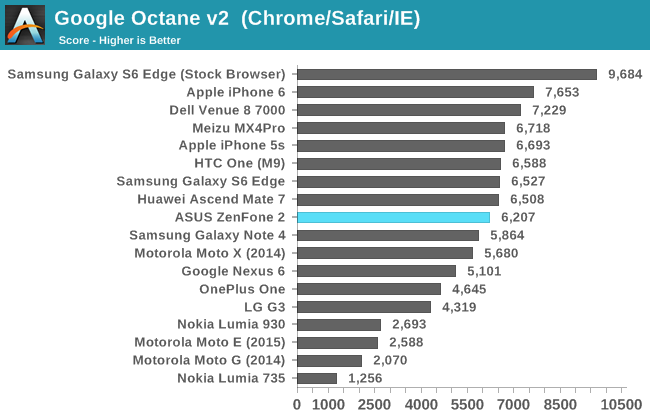
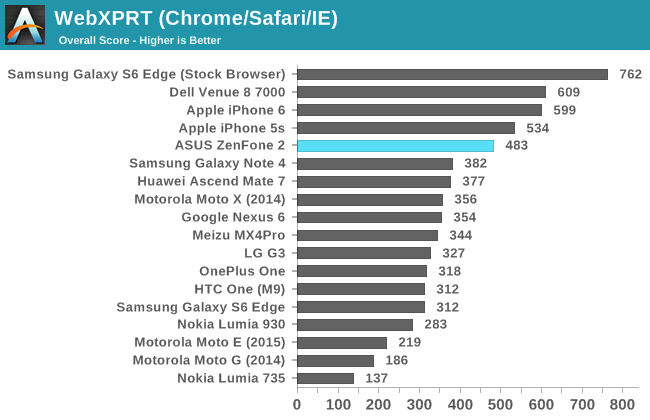
In our web browsing tests the ZenFone 2 performs very well. In the case of Kraken, it does roughly as well as the Venue 8 7000 which uses the same Z3580 SoC. Performance tends to fall behind the Venue 8 in our longer tests like Octane and WebXPRT. I don't have the Venue 8 anymore, but it's a safe bet that this is due to the larger aluminum chassis of the Venue 8 being able to manage heat better in order to keep the clock speeds on the CPU higher during the course of the test.
While the ZenFone 2 isn't quite as fast as a tablet using the same SoC, it's much faster than most of the other devices that we've tested. In general it ends up being a bit slower than the iPhone 5s and the iPhone 6, and of course it loses to the Galaxy S6 using Samsung's browser by an enormous margin in every case. However, a good portion the phones that sit below it are very expensive flagship phones like the Nexus 6, LG G3, and the Galaxy Note 4 which is very impressive for a $300 smartphone.
The next test is Basemark OS II which tests the performance of a device's CPU, GPU, RAM, and NAND.
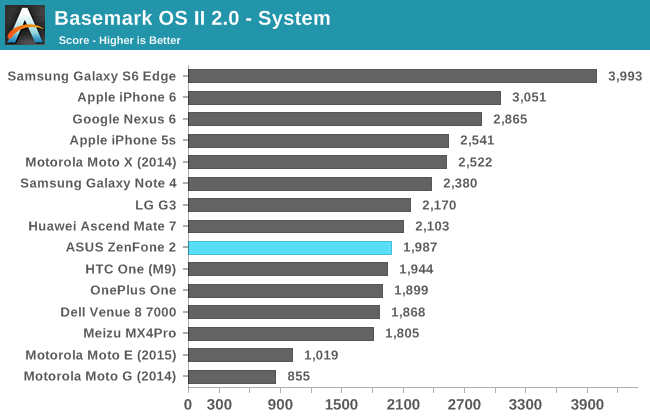
The system sub test performs integer and floating point operations, and also performs some tests like XML parsing. This makes it primarily a test of the device's CPU and RAM. I'm actually somewhat surprised by the ZenFone's performance in this test. By no means is it bad, but I had forgotten that the Venue 8 also struggled to match Snapdragon 801 smartphones in this test.
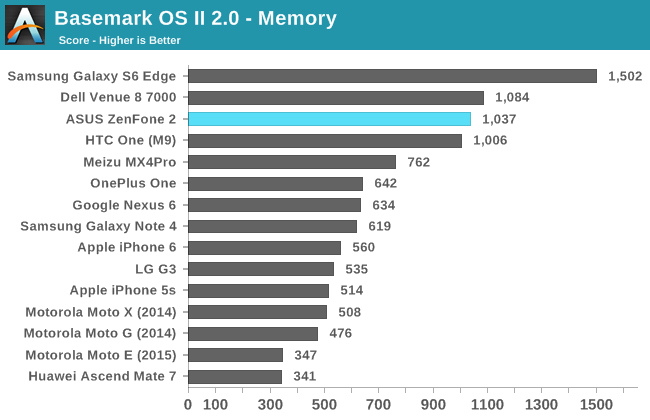
The Basemark OS II memory sub test has a somewhat vague name. While one might expect it to be a test of the device’s RAM, it’s actually a flash storage test. In it we see one of the highest scores of the smartphones we’ve tested, with only the Dell Venue 8 tablet and the Galaxy S6 with its UFS memory achieving higher scores.
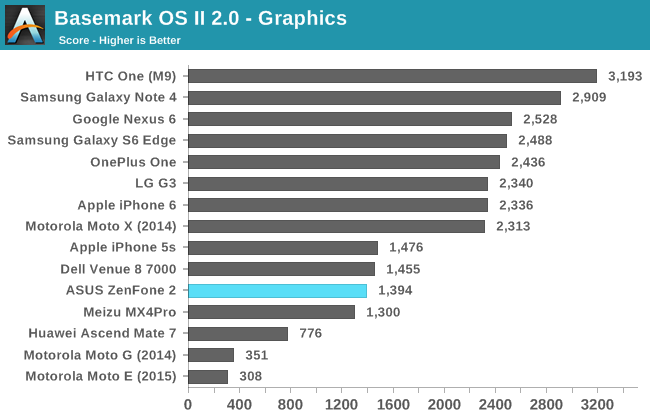
The result in the graphics test is definitely on the lower end of our results, but it’s not unexpected. Both the Venue 8 7000 and the iPhone 5s achieve similar scores, and all three devices use the same G6430 GPU (albeit with lower clock speeds on the iPhone). Even though the ZenFone 2 doesn’t perform as well as the expensive flagship smartphones, it’s far ahead of budget devices like the Moto G. Since both the Z3560 and Z3580 based ZenFone 2 models use the same 533MHz PowerVR G6430 this result should be roughly the same on the $199 model as it is on this $299 model.

The last sub test is the web test. This test focuses on a device’s ability to handle web page rendering, with a focus on HTML5 and CSS rather than Javascript code. In this test we see the ZenFone 2 amongst a large group of devices that includes the HTC One (M9), the Nexus 6, and the Moto X. To see the same level of performance as Snapdragon 805 and 810 devices is very impressive.
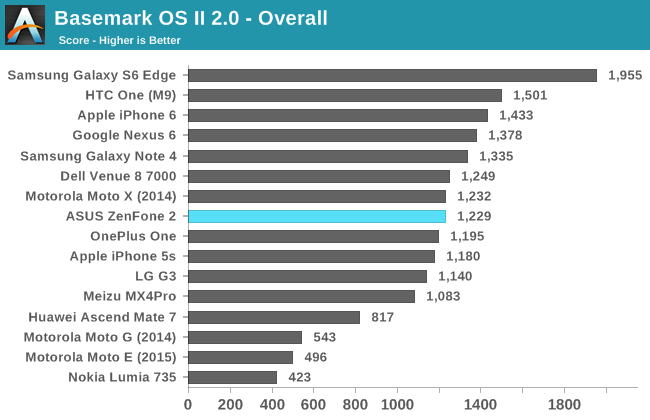
The overall score for BaseMark OS II takes into the account the scores of the various sub tests to generate a final score. In this test we again see the ZenFone 2 around the middle of the pack, with a score that is similar to that of Snapdragon 801 based devices. This is a very good result for a smartphone that costs so little, although the OnePlus One also achieves similar performance at roughly the same price as the $299 model of the ZenFone we are testing.
Our last general performance benchmark is PCMark. This is a relatively new addition to our testing workflow, and it focuses on race to sleep scenarios that reflect the type of usage a device will see in the real world. The tests range from Javascript performance, to playing and seeking in videos, to editing photos.

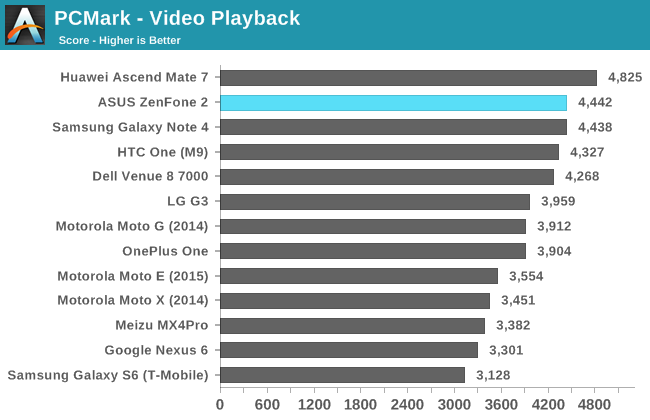
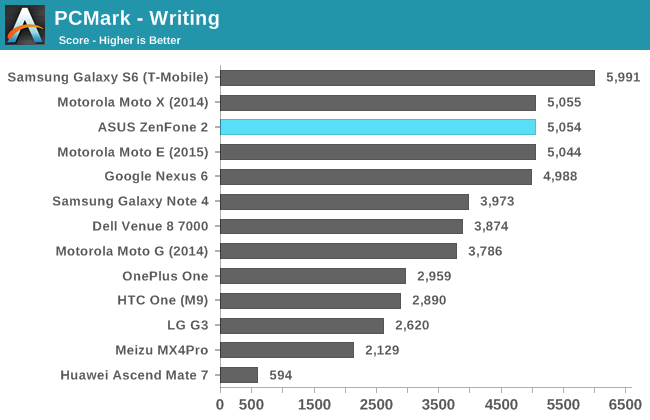
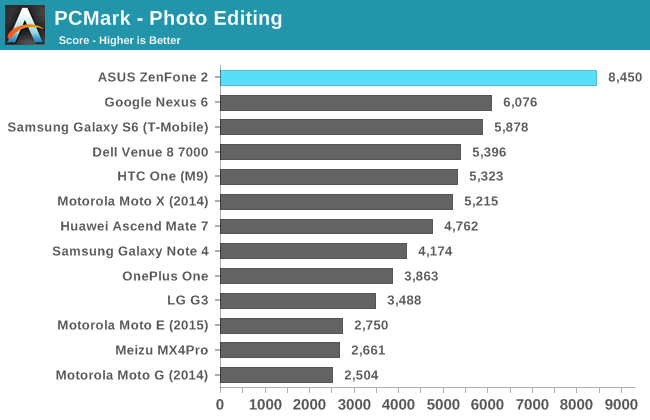
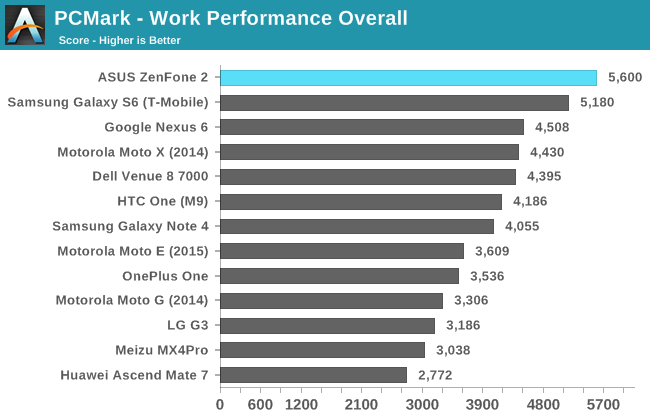
In all of the PCMark sub tests the ZenFone 2 performs extremely well. It’s always at or very close to the top result, and only really loses by a large margin to the Galaxy S6 in the tests that it isn’t right near the top for. The one exception is the photo editing test where it beats every other device by an enormous amount. This score is what carries it to the top position when it comes to the overall score.
I think it’s a bit unfair to say that the ZenFone is the fastest device when it only comes first in a single test, but even without considering the photo editing test it’s clear that the ZenFone 2 offers great performance. Even more amazing is that at times it can trade blows with flagship phones that cost much more than it does. Perhaps due to the fact that it's the only x86 Silvermont-based phone in our benchmarks its relative performance can bounce around versus the competition, but on average it comes rather close to delivering the kind of CPU performance we've seen from the flagship phones over the past year.










147 Comments
View All Comments
aungmyokhing - Friday, September 4, 2015 - link
Zenfone2 have Touch Screen Error. I bought last 3 months. Now appear that Error. Now I can't use my phone. Very stupid condition!aungmyokhing - Friday, September 4, 2015 - link
My phone have no damage. No cracked. That error was appear automatically.aungmyokhing - Friday, September 4, 2015 - link
I used Zenfone 2 ZE551ML. My phone serial number is F4AZFG02X506.aungmyokhing - Friday, September 4, 2015 - link
Zenfone 2 have the so many errors. That shouldn't for use.Lyte - Saturday, April 9, 2016 - link
I recently bought the Zenfone 2 4GB RAM 64 GB model, and I could say the battery life sucks. One time it lasted for only about 4 hours on minimal use, and Ive already uninstalled and/or disabled the apps which aren't very useful and are just battery drainers. Any suggestions on how I can improve it's batterly life? Also I came from a Galaxy J7, and I could say the display is subpar to that of the super AMOLED 1280x720 display of the J7.Mike0902 - Wednesday, June 8, 2016 - link
I bought the same model as you and have to agree that the battery life is a known problem with this phone. I could probably make it through the day just so long as I don't play power hungry games at anytime. When I bought this phone it seems people were blaming the OS saying it was a known problem with Android 5 and there would be an update to 5.1 which should improve the battery life. As yet after 8 long months no update has been received even though Asus have sent out other updates during that time. From what I can gather now is that Asus are planning to skip 5.1 and go straight to Android 6.0. I shall only believe it when I see it especially with the broken promises of 5.1. I did a test to see exactly what was eating the battery and first off did a test by turning everything off using 'flight mode', increasing the brightness to maximum and keeping the screen on continuously to see how long it lasted before the battery gave out. It stayed on for an incredible 8 hours before the battery cried enough. It clearly isn't the screen that is responsible and I now run my phone on 75% brightness whereas before I was dimming it in the belief if would make the battery last longer. I have Sonic Dash installed on my phone which is a known power hungry game but I can play that for as long as my Nokia 1520 which is surprising as I was expecting the battery to plummet as soon as I started playing. Even saved videos play at full brightness without a massive battery drain so just what is causing the battery life to be so crap when in normal use? I have 2 SIM cards installed with SIM 1 using 4G and that is known to be power hungry but the biggest fall of all is when you start to use the internet through Google Chrome. The battery literally goes into freefall and will drop at a rate of approximately 1% every minute so a full charge would give you less than 2 hours of web surfing which is abysmal compared with other phones, therefore it seems the biggest eater of power is that Intel 2.3GHz processor. I can have an hours calling time using 4G and only use 10% of the battery but anything that uses the internet, which is just about every app installed, has to be refused permission to auto start and run in the background eating up the power. You can deny virtually all the apps from starting using the Auto Start Manager and I have also found it helps to run Clean Master at regular intervals to close down apps that have been used and get rid of junk files that build up. It's not strictly the answer but it does help and it does make the battery last longer and just about sees me through a day. With regard to the promised upgrade to Android 6.0, I wouldn't hold your breath on that one, I shall only believe it when I see it.Mike0902 - Wednesday, June 8, 2016 - link
Just as an after thought, if you only want to use your phone for calling and texting through the day go into the settings and turn off mobile data. No app can drain power then.